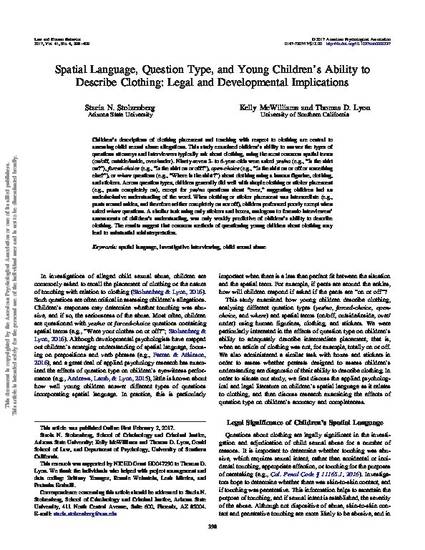
Article
57. Spatial Language, Question Type, and Young Children’s Ability to Describe Clothing: Legal and Developmental Implications.
Law & Human Behavior
(2017)
Abstract
Children’s descriptions of clothing placement and touching with respect to clothing are central to assessing child sexual abuse allegations. This study examined children’s ability to answer the types of questions attorneys and interviewers typically ask about clothing, using the most common spatial terms (on/off, outside/inside, over/under). Ninety-seven 3- to 6-year-olds were asked yes/no (e.g. “Is the shirt on?”), forced-choice (e.g., “Is the shirt on or off?”), open-choice (e.g., “Is the shirt on or off or something else?”), or where questions (e.g., “Where is the shirt?”) about clothing using a human figurine, clothing, and stickers. Across question types, children generally did well with simple clothing or sticker placement (e.g. pants completely on), except for yes/no questions about “over,” suggesting children had an underinclusive understanding of the word. When clothing or sticker placement was intermediate (e.g., pants around ankles, and therefore neither completely on nor off), children performed poorly except when asked where questions. A similar task using only stickers and boxes, analogous to forensic interviewers’ assessments of children’s understanding, was only weakly predictive of children’s ability to describe clothing. The results suggest that common methods of questioning young children about clothing may lead to substantial misinterpretation.
Keywords
- spatial language,
- investigative interviewing,
- child sexual abuse,
- child neglect,
- child testimony
Disciplines
Publication Date
January 1, 2017
Citation Information
Stolzenberg, S. N., McWilliams, K., & Lyon, T. D. (2017). Spatial language, question type, and young children’s ability to describe clothing: Legal and developmental implications. Law and Human Behavior, 41, 398-409.
